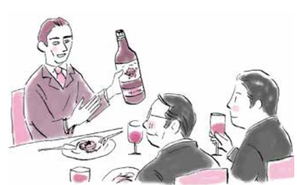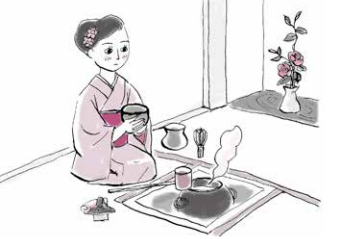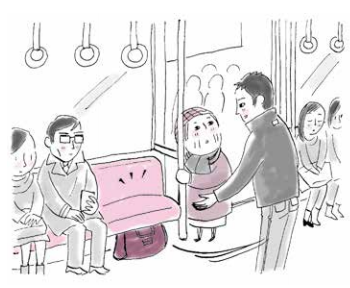Craze for Friendly and Cute Rabbits 人なつこくてひとかわいいウサギが人気
The rabbit is a popular animal (1 in ) Japan. Many rabbits show (2 up ) in Japanese fairy tales and children’s stories. Wild rabbits can’t be seen (3 in ) the center of large cities, but most pet shops have rabbits. In order to get closer (4 to ) them, some people go to rabbit cafes or visit an island that is home to large numbers (5 of ) rabbits.
ウサギは日本で人気のある動物です。日本の昔話や童話にはウサギの出てくる話がたくさんあります。都心で野生のウサギを見ることはありませんが、たいていのペットショップではウサギを販売しています。ウサギとふれあうためにウサギカフェへ行ったり、ウサギがたくさん住んでいる島を訪れたりする人もいます。
At the With Bunny cafe (6 in ) Asakusa, Taito City, Tokyo Prefecture, people go to see, play with, and learn (7 about ) different types of rabbits. In the five-story building, customers can spend time (8 with ) whichever rabbit appeals to them. (9 On ) the walls are photos of rabbits and posters in Japanese and English explaining their behavior and how to rear them. (10 On ) the rooftop, there’s a vegetable garden in which basil and Brussel sprouts are planted. You can watch the rabbits eating them and burrowing (11 into ) the soil. As toys are provided (12 for ) the rabbits, it’s possible to watch them playing; pushing balls (13 around ) and so forth. Rabbit related merchandise is also (14 on ) sale.
東京都台東区にあるWith Bunny浅草店は、いろいろな種類のウサギを見たり一緒に遊んだり学んだりするためのカフェです。お客は5 階建てのビル内で好きなウサギを選び過ごします。壁にはウサギの写真や、習性や飼い方について日本語と英語で書いた紙がはられています。屋上の菜園にはバジルや芽キャベツなどが植えてあり、ウサギがそれらを食べたり土を掘ったりする様子を観察できます。ウサギのためにおもちゃが置かれていて、ボールを転がして遊ぶ様子が見られます。ウサギ関連グッズも販売しています。
(15 At ) the time of writing, the cafe has 26 rabbits of eight different species. “We also have quite a few non-Japanese customers,” says the owner Tomoyuki Kawaoka. “It seems that some foreign tourists visiting Asakusa Temple nearby stopped in and spread the word (16 through ) social media. I get the impression that the friendliness and intelligence (17 of ) rabbits is refreshing to people from countries where rabbits are not commonly kept (18 as ) pets, or where it’s forbidden to keep rabbits.”
現在、8種類26羽のウサギがいます。「外国人のお客様もたくさん来てくださいます」とオーナーの川岡智之さんは言います。「近くにある浅草寺に来た外国人観光客が立ち寄り、SNSで広まったようです。ウサギをペットとして飼う習慣がない国や、飼育が禁じられている国から来た方には特に、ウサギの人なつこさや賢さが新鮮らしいですね」。
Nicolas House is a rabbit-themed cafe (19 in ) Shibuya City, Tokyo Prefecture. Customers don a pair (20 of ) bunny ears when they enter the cafe here – which is decorated (21 with ) stuffed toy rabbits and paintings of rabbits. Several types of bunny ears are available (22 on ) loan and customers who visit frequently can borrow ones (23 with ) lots of flowers and ribbons.
東京都と渋谷区には、ウサギをテーマにしたカフェ、ニコラハウスがあります。ウサギのぬいぐるみや絵で飾ざられており、お客はウサギ耳のカチューシャを付けて入店します。耳は何種類かあり、よく来店するお客はたくさんの花やリボンがついた耳を借りることができます。
Items (24 on ) the cafe’s menu include a rabbit-shaped parfait, cream puffs, and a French dish served (25 in ) the shape of a rabbit’s face. In addition to products (26 with ) rabbit motifs, the cafe sells rabbit-shaped cream puffs and crepes made in-store. The sweets and dishes are original recipes created (27 by ) Charles Nicolas, a French chef who once worked for a one-Michelin-star restaurant.
カフェで出されるメニューはウサギの形をしたパフェやシュークリーム、ウサギの顔型に盛りつけたフランス料理などです。ウサギの形のシュークリームやクレープを作って売っている他、ウサギをモチーフにした雑貨も販売しています。スイーツや料理は、ミシュラン一星レストランで働いていたフランス人シェフ、ニコラ・シャールさんが考案したオリジナルメニューです。
Nicolas himself serves customers, often wearing a pair (28 of ) bunny ears. “Rabbits are the reason I came (29 to ) Japan,” says Nicolas. “When I was a child, my mother bought me a calendar (30 with ) Japanese motifs, such as Mt. Fuji, on it. A picture of cherry blossoms and a white rabbit attracted me so much that I hoped to come (31 to ) Japan one day and ended up settling down here. That’s why I continue to make the dishes and sweets of France, my mother country, (32 in ) the shape of rabbits.”
ニコラさん自身も、ときどきウサギ耳をつけて接客をしています。「ウサギは、私が日本に来るきっかけになった動物なんです」とニコラさん。「子どものとき、母が富士山など日本をモチーフにしたカレンダーを買ってくれたのです。私はその中にあった桜と白ウサギの絵にとてもひかれました。いつか日本に行きたいと思い、ついには住むことになりました。だから私の母国フランスの料理やお菓子を、ウサギの形で作り続つづけています」
The rabbit is a popular animal (1 in ) Japan. Many rabbits show (2 up ) in Japanese fairy tales and children’s stories. Wild rabbits can’t be seen (3 in ) the center of large cities, but most pet shops have rabbits. In order to get closer (4 to ) them, some people go to rabbit cafes or visit an island that is home to large numbers (5 of ) rabbits.
ウサギは日本で人気のある動物です。日本の昔話や童話にはウサギの出てくる話がたくさんあります。都心で野生のウサギを見ることはありませんが、たいていのペットショップではウサギを販売しています。ウサギとふれあうためにウサギカフェへ行ったり、ウサギがたくさん住んでいる島を訪れたりする人もいます。
At the With Bunny cafe (6 in ) Asakusa, Taito City, Tokyo Prefecture, people go to see, play with, and learn (7 about ) different types of rabbits. In the five-story building, customers can spend time (8 with ) whichever rabbit appeals to them. (9 On ) the walls are photos of rabbits and posters in Japanese and English explaining their behavior and how to rear them. (10 On ) the rooftop, there’s a vegetable garden in which basil and Brussel sprouts are planted. You can watch the rabbits eating them and burrowing (11 into ) the soil. As toys are provided (12 for ) the rabbits, it’s possible to watch them playing; pushing balls (13 around ) and so forth. Rabbit related merchandise is also (14 on ) sale.
東京都台東区にあるWith Bunny浅草店は、いろいろな種類のウサギを見たり一緒に遊んだり学んだりするためのカフェです。お客は5 階建てのビル内で好きなウサギを選び過ごします。壁にはウサギの写真や、習性や飼い方について日本語と英語で書いた紙がはられています。屋上の菜園にはバジルや芽キャベツなどが植えてあり、ウサギがそれらを食べたり土を掘ったりする様子を観察できます。ウサギのためにおもちゃが置かれていて、ボールを転がして遊ぶ様子が見られます。ウサギ関連グッズも販売しています。
(15 At ) the time of writing, the cafe has 26 rabbits of eight different species. “We also have quite a few non-Japanese customers,” says the owner Tomoyuki Kawaoka. “It seems that some foreign tourists visiting Asakusa Temple nearby stopped in and spread the word (16 through ) social media. I get the impression that the friendliness and intelligence (17 of ) rabbits is refreshing to people from countries where rabbits are not commonly kept (18 as ) pets, or where it’s forbidden to keep rabbits.”
現在、8種類26羽のウサギがいます。「外国人のお客様もたくさん来てくださいます」とオーナーの川岡智之さんは言います。「近くにある浅草寺に来た外国人観光客が立ち寄り、SNSで広まったようです。ウサギをペットとして飼う習慣がない国や、飼育が禁じられている国から来た方には特に、ウサギの人なつこさや賢さが新鮮らしいですね」。
Nicolas House is a rabbit-themed cafe (19 in ) Shibuya City, Tokyo Prefecture. Customers don a pair (20 of ) bunny ears when they enter the cafe here – which is decorated (21 with ) stuffed toy rabbits and paintings of rabbits. Several types of bunny ears are available (22 on ) loan and customers who visit frequently can borrow ones (23 with ) lots of flowers and ribbons.
東京都と渋谷区には、ウサギをテーマにしたカフェ、ニコラハウスがあります。ウサギのぬいぐるみや絵で飾ざられており、お客はウサギ耳のカチューシャを付けて入店します。耳は何種類かあり、よく来店するお客はたくさんの花やリボンがついた耳を借りることができます。
Items (24 on ) the cafe’s menu include a rabbit-shaped parfait, cream puffs, and a French dish served (25 in ) the shape of a rabbit’s face. In addition to products (26 with ) rabbit motifs, the cafe sells rabbit-shaped cream puffs and crepes made in-store. The sweets and dishes are original recipes created (27 by ) Charles Nicolas, a French chef who once worked for a one-Michelin-star restaurant.
カフェで出されるメニューはウサギの形をしたパフェやシュークリーム、ウサギの顔型に盛りつけたフランス料理などです。ウサギの形のシュークリームやクレープを作って売っている他、ウサギをモチーフにした雑貨も販売しています。スイーツや料理は、ミシュラン一星レストランで働いていたフランス人シェフ、ニコラ・シャールさんが考案したオリジナルメニューです。
Nicolas himself serves customers, often wearing a pair (28 of ) bunny ears. “Rabbits are the reason I came (29 to ) Japan,” says Nicolas. “When I was a child, my mother bought me a calendar (30 with ) Japanese motifs, such as Mt. Fuji, on it. A picture of cherry blossoms and a white rabbit attracted me so much that I hoped to come (31 to ) Japan one day and ended up settling down here. That’s why I continue to make the dishes and sweets of France, my mother country, (32 in ) the shape of rabbits.”
ニコラさん自身も、ときどきウサギ耳をつけて接客をしています。「ウサギは、私が日本に来るきっかけになった動物なんです」とニコラさん。「子どものとき、母が富士山など日本をモチーフにしたカレンダーを買ってくれたのです。私はその中にあった桜と白ウサギの絵にとてもひかれました。いつか日本に行きたいと思い、ついには住むことになりました。だから私の母国フランスの料理やお菓子を、ウサギの形で作り続つづけています」





 RSS Feed
RSS Feed